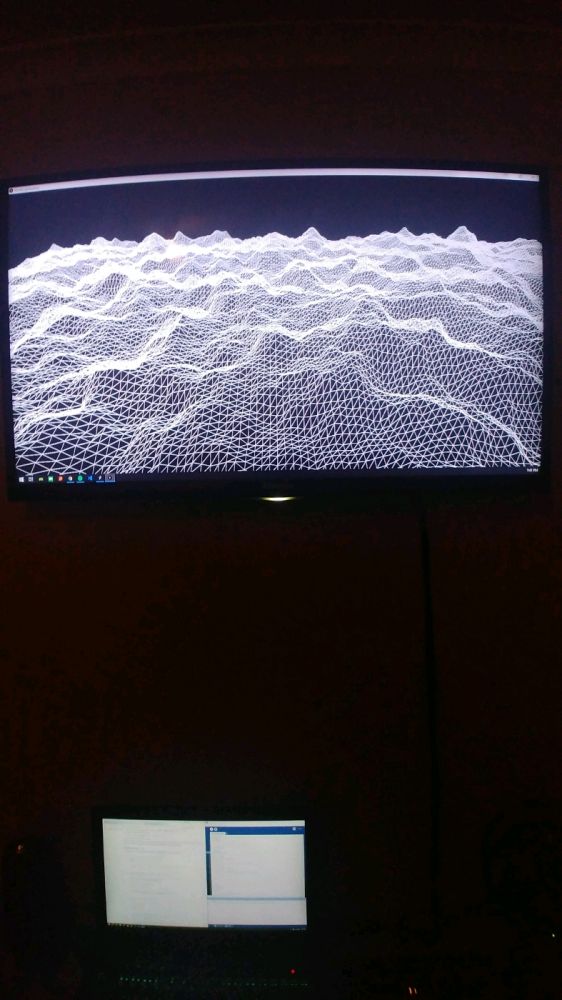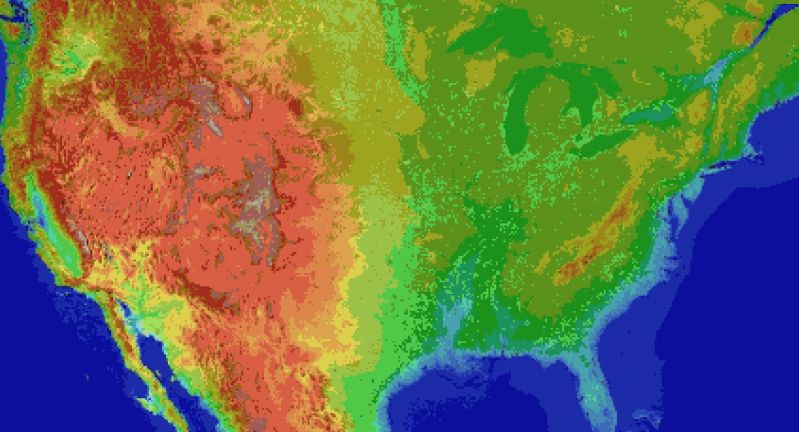Join devRant
Do all the things like
++ or -- rants, post your own rants, comment on others' rants and build your customized dev avatar
Sign Up
Pipeless API

From the creators of devRant, Pipeless lets you power real-time personalized recommendations and activity feeds using a simple API
Learn More
Search - "terrain"
-
3 people for developing the prototype including me.
One person knows unity. He started modeling the terrain in that.
Another person knows 3D modelling. He started designing the bots.
I don't know unity or C#. I started implementing the logic :/
It was the worst experience but learned shitloads from it in 2 days.3 -
So, I've been following a tutorial and explanatory series on YouTube about procedural terrain generation.
I dare saying it's going quite well! 20
20 -
Programming Languages are Like Cars:
Assembler: A formula I race car. Very fast but difficult to drive and maintain.
FORTRAN II: A Model T Ford. Once it was the king of the road.
FORTRAN IV: A Model A Ford.
FORTRAN 77: a six-cylinder Ford Fairlane with standard transmission and no seat belts.
COBOL: A delivery van. It's bulky and ugly but it does the work.
BASIC: A second-hand Rambler with a rebuilt engine and patched upholstery. Your dad bought it for you to learn to drive. You'll ditch it as soon as you can afford a new one.
PL/I: A Cadillac convertible with automatic transmission, a two-tone paint job, white-wall tires, chrome exhaust pipes, and fuzzy dice hanging in the windshield.
C++: A black Firebird, the all macho car. Comes with optional seatbelt (lint) and optional fuzz buster (escape to assembler).
ALGOL 60: An Austin Mini. Boy that's a small car.
ALGOL 68: An Aston Martin. An impressive car but not just anyone can drive it.
Pascal: A Volkswagon Beetle. It's small but sturdy. Was once popular with intellectual types.
liSP: An electric car. It's simple but slow. Seat belts are not available.
PROLOG/LUCID: Prototype concept cars.
FORTH: A go-cart.
LOGO: A kiddie's replica of a Rolls Royce. Comes with a real engine and a working horn.
APL: A double-decker bus. It takes rows and columns of passengers to the same place all at the same time but it drives only in reverse and is instrumented in Greek.
Ada: An army-green Mercedes-Benz staff car. Power steering, power brakes, and automatic transmission are standard. No other colors or options are available. If it's good enough for generals, it's good enough for you.
Java: All-terrain very slow vehicle.10 -
For those keeping track of what inwas doing here: https://devrant.com/rants/1641742/...
Inhave been playing around woth fractals and making trees (although it wasnt 3 dementional) i have been taking time to learn things there regardless and had an attempt at making a landscape using Perlin noise procedurally generated by the computer
I am planning on releasing the code as soon as i figure out making these trees geberate at certain points of the land and firstly, make it branch in a 3 dementional space
Update of the land
Although i dont have the most time to so this and had to learn java in the process to move away from the limitations i had in the browser. It is a fun experiance and good break away from my actual job.
Ill see how it goes while working on this
✌ 6
6 -
On the game front, I see so much conflicting advice. "Start getting feedback" as soon as possible. "Donnt soft launch on steam! The algol will wreck you.", "soft launch on itch to get feedback", "dont soft launch on itch!"
"Start marketing today", "focus on influencers", "get to know communities *before* you advertise", "dont get to know communities beforehand if you're just planning on self prompting", "dont self promote".
"CPM is important.", "CPA is important". Etc.
Sounds a lot like "have a bunch of money upfront." The solution is just to succeed from the start! It's so obvious. Just invent the next gta. The next facebook. Get a small loan of 50,000 dollars, or a million. Donate for a year to other kickstarter projects so people will know you and reciprocate! But also dont ebeg!
How about no. How about fuck all this advice by silver spoon assholes that didnt have to work on shoestring budgets. The advice is the equivalent of having a 300 page tonedeaf book, every page blank except page 150, where the words "fuck you. I got mine." Are printed in times new Roman, 14pt font, neatly in the center of the page.
The truth is most of the "indies" already made it in the software industry proper, before switching over. $5k kickstarter videos, with $15k marketing budgets, no doubt funded in part through their own money funneled through services that provide shell donations, because KS is being used as a glorified advertising service. People buying off steam curators for promotions, youtubers making sponsored videos without disclosing they're sponsored. Fake viralility. Fake campaigns. Predetermined success for those who could *already* afford to develop and go commercial without a publisher. And they came into the market and cannibalized the opportunity, raising the bar for everyone that wasnt them. I guess that's actually a good thing, because we wouldnt have half the amazing games we do, and the pressure to produce quality. But then I see fantastic games utterly ignored or flailing in an attempt to compete for eyeballs in an industry frequently dominated by gatekeeping marketeers and influencers, where human grace determines success or complete oblivion. And I'm just disgusted with it.
Also buy my game. Preorder NOW! And you'll get a REAL canvas bag, I'll go to like the goodwill and buy one and screen print the game logo on it or some shit. Buy the special collectors edition and get pictures of my feet. Buy the game of the year edition and get a real gasmask. Preorder now and I'll fucking suck your di k right now. No lie. Preorder the diamond edition RIGHT NOW in the next six minutes and I will send you one hundred thousand dollars in gold plated bottle caps. Limited supply. one million per customer. Offer expires soon. This is not a scam. I repeat. This is NOT a scam.
In other news I'm soft launching Atom Ranger in six months (assuming the nuclear apocalypse hasn't *actually* started by then). Its state of decay and fallout meets rimworld. Build and manage a sprawling base, resolving conflicts, exploring post apocalyptic Colorado and surrounding territories of no-mans-land. Navigate hazardous weather, radioactive terrain, collapsed bridges, dangerous rivers, and deal with cultists, bandits, slavers, and hungry cannibals. Broker peace between not just the factions outside your settlements, but within your base too. Manage conflicts, settle disputes, avert disasters, barter, scavenge, and survive in a fully dynamic world, where buildings slowly crumble, grass and trees sprout up in the road and vacant lots, fires burn out of control, and factions loot, ruin, and takeover settlements. Watch the world and the survivors in it change and survive. Help them to survive, or become a warlord and rule over the wastes.
Lets be honest. It's basically kenshi but less complicated.
If you want to volunteer to test (instead of paying to be a glorified tester, aka "alpha") let me know in the comments.
I'm currently setting up a discord and mailing list.28 -
When I was in school, people came to me every once in a while, wanting to make a new great MMORPG with destructible terrain and factions.
Then came the guys who wanted to make a new amazing app that will help them fix some minor life inconveniences (like tracking expiry dates on the groceries in your fridge).
And now there are guys who want to make blockchain, IoT and chatbot based startups.
I just want to watch youtube and post shit on the internet. :(1 -
Everyone and their dog is making a game, so why can't I?
1. open world (check)
2. taking inspiration from metro and fallout (check)
3. on a map roughly the size of the u.s. (check)
So I thought what I'd do is pretend to be one of those deaf mutes. While also pretending to be a programmer. Sometimes you make believe
so hard that it comes true apparently.
For the main map I thought I'd automate laying down the base map before hand tweaking it. It's been a bit of a slog. Roughly 1 pixel per mile. (okay, 1973 by 1067). The u.s. is 3.1 million miles, this would work out to 2.1 million miles instead. Eh.
Wrote the script to filter out all the ocean pixels, based on the elevation map, and output the difference. Still had to edit around the shoreline but it sped things up a lot. Just attached the elevation map, because the actual one is an ugly cluster of death magenta to represent the ocean.
Consequence of filtering is, the shoreline is messy and not entirely representative of the u.s.
The preprocessing step also added a lot of in-land 'lakes' that don't exist in some areas, like death valley. Already expected that.
But the plus side is I now have map layers for both elevation and ecology biomes. Aligning them close enough so that the heightmap wasn't displaced, and didn't cut off the shoreline in the ecology layer (at export), was a royal pain, and as super finicky. But thankfully thats done.
Next step is to go through the ecology map, copy each key color, and write down the biome id, courtesy of the 2017 ecoregions project.
From there, I write down the primary landscape features (water, plants, trees, terrain roughness, etc), anything easy to convey.
Main thing I'm interested in is tree types, because those, as tiles, convey a lot more information about the hex terrain than anything else.
Once the biomes are marked, and the tree types are written, the next step is to assign a tile to each tree type, and each density level of mountains (flat, hills, mountains, snowcapped peaks, etc).
The reference ids, colors, and numbers on the map will simplify the process.
After that, I'll write an exporter with python, and dump to csv or another format.
Next steps are laying out the instances in the level editor, that'll act as the tiles in question.
Theres a few naive approaches:
Spawn all the relevant instances at startup, and load the corresponding tiles.
Or setup chunks of instances, enough to cover the camera, and a buffer surrounding the camera. As the camera moves, reconfigure the instances to match the streamed in tile data.
Instances here make sense, because if theres any simulation going on (and I'd like there to be), they can detect in event code, when they are in the invisible buffer around the camera but not yet visible, and be activated by the camera, or deactive themselves after leaving the camera and buffer's area.
The alternative is to let a global controller stream the data in, as a series of tile IDs, corresponding to the various tile sprites, and code global interaction like tile picking into a single event, which seems unwieldy and not at all manageable. I can see it turning into a giant switch case already.
So instances it is.
Actually, if I do 16^2 pixel chunks, it only works out to 124x68 chunks in all. A few thousand, mostly inactive chunks is pretty trivial, and simplifies spawning and serializing/deserializing.
All of this doesn't account for
* putting lakes back in that aren't present
* lots of islands and parts of shores that would typically have bays and parts that jut out, need reworked.
* great lakes need refinement and corrections
* elevation key map too blocky. Need a higher resolution one while reducing color count
This can be solved by introducing some noise into the elevations, varying say, within one standard div.
* mountains will still require refinement to individual state geography. Thats for later on
* shoreline is too smooth, and needs to be less straight-line and less blocky. less corners.
* rivers need added, not just large ones but smaller ones too
* available tree assets need to be matched, as best and fully as possible, to types of trees represented in biome data, so that even if I don't have an exact match, I can still place *something* thats native or looks close enough to what you would expect in a given biome.
Ponderosa pines vs white pines for example.
This also doesn't account for 1. major and minor roads, 2. artificial and natural attractions, 3. other major features people in any given state are familiar with. 4. named places, 5. infrastructure, 6. cities and buildings and towns.
Also I'm pretty sure I cut off part of florida.
Woops, sorry everglades.
Guess I'll just make it a death-zone from nuclear fallout.
Take that gators! 5
5 -
!rant
I've been posting "dev logs", if you can call them that, to YouTube every now and then as I make progress with this funny little app I'm making. They're just videos of me testing something in the app with background music.
But today, someone was interested enough in my terrain generation, to ask for a tutorial, and I got my first subscriber!
Everything's coming up Milhouse! -
Question and Update.
First of all, I would like to thank @ScriptCoded for an idea in the previous post, so then I have beautiful terrain now, and the complete world map generated like plots, and each of them consists of 5x5 different plots defined by neighbors :) Hired a digital artist who is working on much nicer plots as well.
The new issue is regarding the zoom.
The map is saved as JSON with the pixel-perfect location of each generated plot so I am detecting the collision with the mouse based on their location. After I zoom in, the script is still comparing the pixel location of the element, but the real screen is scaled already so the pointer is off (image2). The problem is described in image3 as well. How can I still get the canvas relative value of the mouse instead of the x,y coordinate on the current zoomed screen? 9
9 -
I‘d like to work more on my 2D game.
The idea is to make a mix of "Factorio" and "Knights and Merchants".
I’ve already got a decent basis with infinite terrain generation and units that collect resources and store them in containers as items.2 -
Looking forward to the day when I'll be building a custom kernel for my "smart shoes" to speed up terrain detection
-
I like to compare OSses to playgrounds
OS x: a grass field with a fence with a watcher that keeps you from doing something possibly dangerous(/fun) . It's safe but not a lot you can do
Windows: a grass field with a fence, you can climb the fence if you want and do dangerous things if you aren't carefull. less safe but you can do more
Linux: a terrain of your choosing, you can do whatever you want, but it can quickly become dangerous if you don't know what your doing.6 -
Data wrangling is messy
I'm doing the vegetation maps for the game today, maybe rivers if it all goes smoothly.
I could probably do it by hand, but theres something like 60-70 ecoregions to chart,
each with their own species, both fauna and flora. And each has an elevation range its
found at in real life, so I want to use the heightmap to dictate that. Who has time for that? It's a lot of manual work.
And the night prior I'm thinking "oh this will be easy."
yeah, no.
(Also why does Devrant have to mangle my line breaks? -_-)
Laid out the requirements, how I could go about it, and the more I look the more involved
it gets.
So what I think I'll do is automate it. I already automated some of the map extraction, so
I don't see why I shouldn't just go the distance.
Also it means, later on, when I have access to better, higher resolution geographic data, updating it will be a smoother process. And even though I'm only interested in flora at the moment, theres no reason I can't reuse the same system to extract fauna information.
Of course in-game design there are some things you'll want to fudge. When the players are exploring outside the rockies in a mountainous area, maybe I still want to spawn the occasional mountain lion as a mid-tier enemy, even though our survivor might be outside the cats natural habitat. This could even be the prelude to a task you have to do, go take care of a dangerous
creature outside its normal hunting range. And who knows why it is there? Wild fire? Hunted by something *more* dangerous? Poaching? Maybe a nuke plant exploded and drove all the wildlife from an adjoining region?
who knows.
Having the extraction mostly automated goes a long way to updating those lists down the road.
But for now, flora.
For deciding plants and other features of the terrain what I can do is:
* rewrite pixeltile to take file names as input,
* along with a series of colors as a key (which are put into a SET to check each pixel against)
* input each region, one at a time, as the key, and the heightmap as the source image
* output only the region in the heightmap that corresponds to the ecoregion in the key.
* write a function to extract the palette from the outputted heightmap. (is this really needed?)
* arrange colors on the bottom or side of the image by hand, along with (in text) the elevation in feet for reference.
For automating this entire process I can go one step further:
* Do this entire process with the key colors I already snagged by hand, outputting region IDs as the file names.
* setup selenium
* selenium opens a link related to each elevation-map of a specific biome, and saves the text links
(so I dont have to hand-open them)
* I'll save the species and text by hand (assuming elevation data isn't listed)
* once I have a list of species and other details, to save them to csv, or json, or another format
* I save the list of species as csv or json or another format.
* then selenium opens this list, opens wikipedia for each, one at a time, and searches the text for elevation
* selenium saves out the species name (or an "unknown") for the species, and elevation, to a text file, along with the biome ID, and maybe the elevation code (from the heightmap) as a number or a color (probably a number, simplifies changing the heightmap later on)
Having done all this, I can start to assign species types, specific world tiles. The outputs for each region act as reference.
The only problem with the existing biome map (you can see it below, its ugly) is that it has a lot of "inbetween" colors. Theres a few things I can do here. I can treat those as a "mixing" between regions, dictating the chance of one biome's plants or the other's spawning. This seems a little complicated and dependent on a scraped together standard rather than actual data. So I'm thinking instead what I'll do is I'll implement biome transitions in code, which makes more sense, and decouples it from relying on the underlaying data. also prevents species and terrain from generating in say, towns on the borders of region, where certain plants or terrain features would be unnatural. Part of what makes an ecoregion unique is that geography has lead to relative isolation and evolutionary development of each region (usually thanks to mountains, rivers, and large impassible expanses like deserts).
Maybe I'll stuff it all into a giant bson file or maybe sqlite. Don't know yet.
As an entry level programmer I may not know what I'm doing, and I may be supposed to be looking for a job, but that won't stop me from procrastinating.
Data wrangling is fun. 1
1 -
Modt excited about code was three days ago, when I managed to make SpeedTrees (that are painted on Unity terrains and not detectable as different from the terrain while using raycasts) transparent when they appear between the camera and the character :P
-
So would you design an ai that handled a unit by unit move and have the inputs be the range layout ?
What if instead of pathing I had to train an ai to faulty human logic about judging terrain to choose to wander down that could cost extra time if you hit a boundary ?6 -
I have an image of a small terrain in my ciry for google maps, I only have this image but I want to search the city for this terrain
Is there any way I can automate the process? Even on a larger scale
Multiple cities2 -
Car Hire in Tanger: Your Trusted Choice with Channasri Car
When planning a trip to Tanger, Morocco, finding a reliable and affordable car hire service is essential to ensure a smooth and enjoyable experience. Whether you are in Tanger for business, leisure, or to explore the rich culture and beautiful landscapes, Channasri Car provides a convenient and cost-effective solution for all your car hire needs in the city. Located at Kissariat Meftah, Av. Prince Heritier, Tanger 93000, Morocco, Channasri Car has built a reputation for excellent service, quality vehicles, and customer satisfaction.
Why Choose Channasri Car for Car Hire in Tanger?
Channasri Car is committed to providing an exceptional car hire experience for both locals and visitors in Tanger. Our fleet of well-maintained vehicles, coupled with our outstanding customer service, makes us a top choice for those looking to rent a car in the city. Whether you're in town for a short trip or need a long-term hire, we offer the perfect solution tailored to your specific requirements.
Affordable and Flexible Car Hire Options
At Channasri Car, we believe that car hire in Tanger should be affordable and accessible for everyone. Our pricing is designed to fit various budgets without compromising on the quality of service. We offer competitive rates, with no hidden fees or unexpected charges, ensuring you get great value for your money. Additionally, we offer flexible rental plans that cater to different timeframes, whether you need a car for a few hours, a day, a week, or even longer.
Our goal is to provide you with the best car hire experience, offering convenient and affordable options that suit both your travel needs and budget.
A Wide Range of Vehicles for Every Need
One of the main reasons customers choose Channasri Car for their car hire in Tanger is the wide variety of vehicles we offer. We understand that every traveler has different needs, and that's why we have a diverse fleet of cars available to meet your specific preferences. Whether you need a compact car for easy city driving, a spacious sedan for family trips, or a rugged SUV for exploring Morocco’s diverse terrain, we have something for everyone.
Our fleet includes:
Economy Cars: Ideal for solo travelers or couples who need an affordable, fuel-efficient car for city navigation.
Sedans: Perfect for those who require a bit more space and comfort, whether for business or leisure purposes.
SUVs: If you're planning to explore the countryside or the rugged areas around Tanger, our SUVs offer the perfect blend of power, comfort, and versatility.
Luxury Cars: For those who want to travel in style, our luxury car options provide the ultimate in comfort and performance.
Each of our vehicles is thoroughly inspected and maintained to ensure safety, reliability, and comfort throughout your rental period. Whether you’re traveling for business or pleasure, you can count on Channasri Car to provide you with a dependable vehicle.
Easy and Convenient Pickup and Drop-off Service
We understand the importance of convenience, and we aim to make your car hire experience as hassle-free as possible. Channasri Car offers convenient pickup and drop-off locations throughout Tanger, ensuring that your rental car is delivered to your location of choice. Whether you are arriving at Tanger Med port, Mohammed V Airport, or a local hotel, we’ll have your car ready and waiting.
Our goal is to save you time and effort, allowing you to focus on enjoying your trip to Tanger without worrying about transportation logistics.
Professional and Friendly Customer Service
At Channasri Car, customer satisfaction is our priority. Our team of professional and friendly staff is dedicated to providing you with personalized service every step of the way. From assisting you with choosing the right vehicle for your needs to offering helpful advice on local attractions, we are always here to ensure you have a smooth and enjoyable car hire experience.
We believe in building long-term relationships with our clients by offering top-notch customer service and addressing any concerns you may have. Our goal is to make your car hire experience in Tanger as easy and stress-free as possible.
Explore the Wonders of Tanger with Ease
Tanger is a city filled with history, culture, and stunning landscapes. With Channasri Car, you can explore all that this incredible destination has to offer at your own pace. Visit the historic Medina, wander through the picturesque streets, or take a drive along the coastline to explore some of the most beautiful beaches in Morocco. With your car hire in Tanger, you’ll have the freedom to discover the city and surrounding areas without any restrictions.
Book Your Car Hire with Channasri Car Today!
If you’re planning a visit to Tanger, Channasri Car is your trusted partner for reliable, affordable, and convenient car hire services. 1
1


